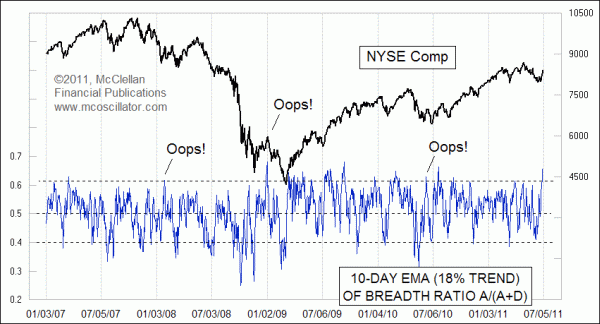by McClellan Financial
The robust end of quarter rally in the stock market has come on strong breadth numbers, meaning that the number of advances has exceeded the number of declines in a big way. When this happens over a period of days, it can constitute a “breadth thrust”.
Different technicians have different definitions for what constitutes a breadth thrust, but to my knowledge the first person to coin that term was Martin Zweig. He talked about a breadth thrust as quatified by a unique indicator tied to the number of advances and declines. Zweig would calculate what he called a 10-day exponential moving average (EMA) of the number of advances divided by advances plus declines, or A/(A+D). In the original terminology of P.N. Haurlan, who first introduced EMAs to the study of price series, a 10-day EMA is an 18% Trend, meaning that 18% is the smoothing constant applied to each new day’s data.
Zweig would say that a breadth thrust occurs when this 10-day EMA dips below a value of 0.40 and then rises above 0.615 within 10 trading days. Such a big reversal signals a huge shift in the momentum of the breadth data, and it shows that there is enough money coming into the market to lift the majority of stocks in a persistent way.
The instances of a qualifying breadth thrust event according to Zweig’s definition are exceedingly rare. By our count, there have only been a handful of actual qualifying signals over several decades.
Gerald Appel adapted Zweig’s idea of a breadth thrust signal, ignoring the requirement to dip below 0.40, but focusing on the rise above a value of 0.615. Appel adapted that to a mechanical trading system he developed in the 1980s, and called such high readings a “breadth thrust continuation signal”. The idea was that when you see one of these, it constitutes a sign that liquidity is so plentiful that any signals to go short in the system would likely not work out very well. So for some period after such a signal, one should ignore any system-generated signals to go short.
This week’s strong breadth data produced a reading of 0.658 as of July 1, which is well above the 0.615 threshold. But as the chart shows, these high readings do not always work out as signals that an uptrend is going to last for a while longer. Sometimes they can mark blowoffs, and this phenomenon of having blowoff market rallies has been much more prevalent in the last few years. A lot of old standards for high and low thresholds have changed lately, thanks to algorithmic trading, the elimination of the uptick rule, and other changes.

As an example, from 1995 to 2002, there were only two instances of this indicator going above 0.615. They happened in May and June of 1997, and they correctly foretold the continuation of the rally that was underway then. But since 2007, when the uptick rule was eliminated, we have seen 17 of these signals, and the reliability is not as good as it once was. I have labeled in the chart 3 notable examples of when a supposed continuation signal actually constituted the peak of a snapback rally that was followed by a retest of the preceding low, or worse.
So while I generally applaud the appearance of consistently strong breadth data, I get increasingly suspicious based on these failures, especially when the rally comes at the end of a quarter as portfolio managers are madly trying to reallocate their assets to make up for the underperformance of stocks and the outperformance of bonds.
I also get suspicious when the rally goes against the script of what is supposed to be happening based on seasonal factors, and based on great leading indications like the one I discussed back on May 27. A rally at the wrong time, even with gobs of positive breadth going for it, can often result in the market working extra hard to get itself back on track.
No comments:
Post a Comment